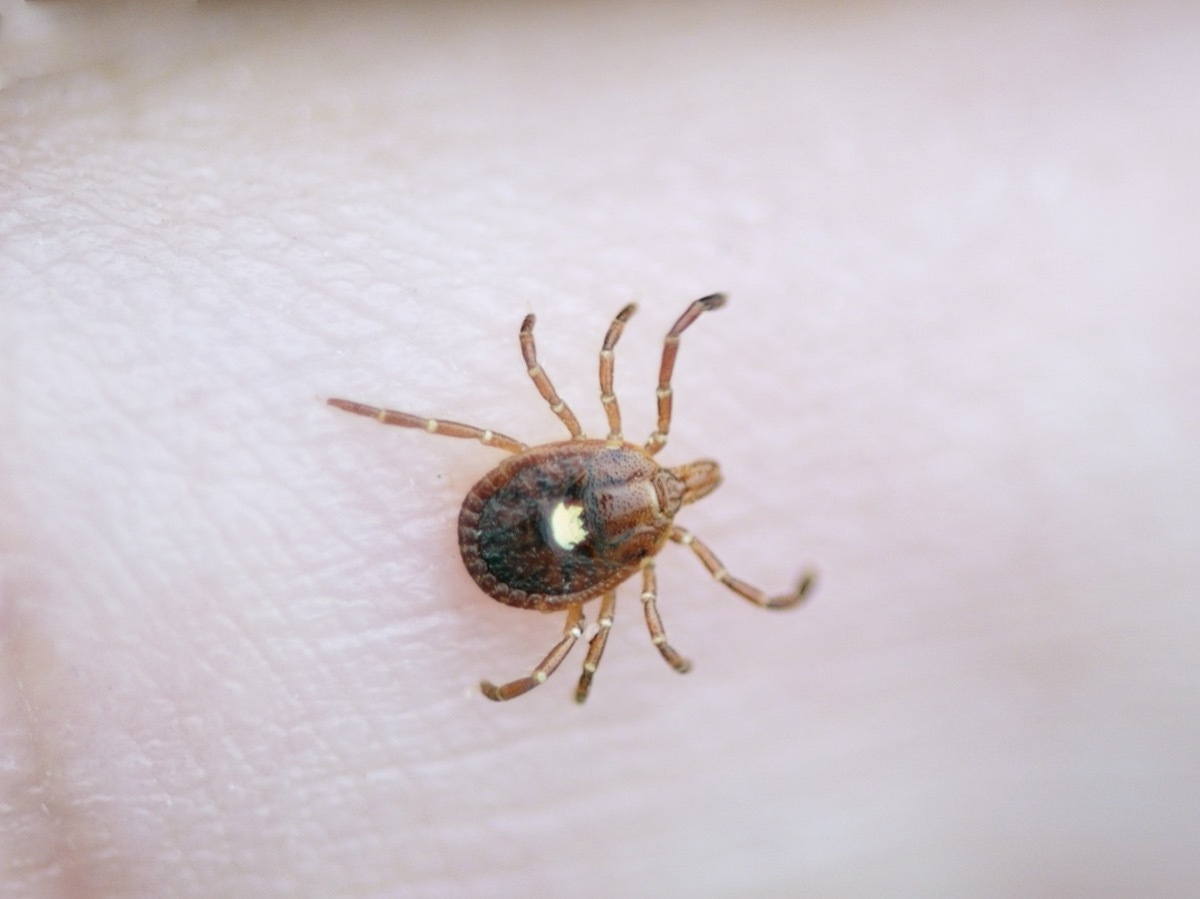Kung napansin mo ito pagkatapos kumain ng karne, tawagan ang iyong doktor, nagbabala ang mga eksperto
Ang problemang pangkalusugan na ito ay nagiging mas laganap dahil sa pagtaas ng isang malawak na peste.

Despite the popularity of vegan and vegetarian diets, a majority of people in the U.S. still do kumain ng karne. In fact, according to a 2021 survey from Ipsos, 9 in 10 Americans currently include meat as part of their diet. With that in mind, it won't be hard for most to spot the symptoms of a concerning health condition that's becoming more and more of a problem thanks to another rising trend. Researchers are warning that the increasing prevalence of one pest across the country could have serious consequences for people's eating habits. Read on to find out what symptoms you should be looking out for.
Basahin ito sa susunod:If You're Over 65, Avoid This One Type of Meat, Experts Say.
Lone star ticks are being found in more places around the U.S.

Researchers have recently found that the presence of one troublesome tick is growing across the U.S., The New York Times reported on May 13. According to the newspaper, the lone star tick—named as such because of the white blotch on females' back—is usually found in the southern part of the country, but experts have started to spot this pest in increasing numbers in parts of the Midwest and the Northwest. Scientists say that this expansion is largely due to global warming, as the ticks have more time to feed on hosts and reproduce when there are more hot days each year.
"What we're now seeing is a wide open door for ticks to continue expanding their range further northward; bringing more people into the fold of the arthropod-borne diseases," Michael Raupp, PhD, a professor emeritus in entomology at the University of Maryland, told The New York Times. "We're venturing into uncharted waters in so many dimensions with climate change."
Basahin ito sa susunod:If You Live Here, Watch Out for Giant Spiders Falling From the Sky.
This tick can trigger a meat allergy in some people.

The lone star tick can spread a number of diseases and health concerns, but one of the most worrying is alpha-gal syndrome (AGS). According to the Mayo Clinic, this condition is "a recently identified type of food allergy to red meat and other products made from mammals," most commonly caused by a bite from a lone star tick. Researchers first started noticing an allergic reaction from alpha-gal in 2006, but they did not connect it to tick bites until several year later, The New York Times reported.
"The bite transmits a sugar molecule called alpha-gal into the person's body," the Mayo Clinic explains. "In some people, this triggers an immune system reaction that later produces mild to severe allergic reactions to red meat, such as beef, pork or lamb, or other mammal products."
If you notice certain symptoms after eating meat, you could have alpha-gal syndrome.

Food allergies are not always severe, but AGS is a "serious, potentially life-threatening allergic reaction," the Centers for Disease Control and Prevention (CDC) warns. According to the agency, symptoms of this condition usually arise two to six hours after eating meat or dairy and can include any of the following: hives, an itchy rash, nausea, vomiting, heartburn, indigestion, diarrhea, cough, shortness of breath, difficulty breathing, a drop in blood pressure, dizziness, faintness, severe stomach pain, and swelling of the lips, throat, tongue, or eyelids.
Deborah Fleshman, a former nurse who has been diagnosed with alpha-gal syndrome, told The New York Times that her symptoms started in 2008 when she woke up to legs that had turned beetroot red and a torso covered in welts, with some being a foot wide. At the time, she said she felt like she was "dying."
"It feels like you're on fire, and then it feels like you slept with a cactus," she said. "The itching is unbearable."ae0fcc31ae342fd3a1346ebb1f342fcb
RELATED: For more up-to-date information, sign up for our daily newsletter.
You should call your doctor if you think you have AGS.

An AGS reaction can also look quite different from person to person, and those with the condition might not have an allergic response every single time they're exposed to meat, according to the CDC. "It's never predictable. I know people that spend the night in the emergency room parking lot, waiting for a reaction," Jennifer Platt, an adjunct professor in public health at the University of North Carolina at Chapel Hill and a co-founder of the nonprofit Tick-Borne Conditions United, explained to The New York Times.
Hindi alintana, dapat mong pag -usapan ang posibilidad ng AGS sa iyong doktor kung nakakaranas ka ng anumang mga sintomas na may kaugnayan sa kondisyon - lalo na kung alam mong nakagat ka ng isang tik. Ayon sa CDC, ang AGS ay dapat tratuhin at pinamamahalaan sa ilalim ng pangangalaga ng mga nagbibigay ng pangangalaga sa kalusugan, dahil maaaring maiwasan ng mga pasyente ang ilang mga pagkain, produkto, bakuna, at gamot.
"Kung sa palagay mo ay maaaring mayroon kang AGS, makipag -usap sa iyong tagapagbigay ng pangangalagang pangkalusugan," payo ng ahensya. "Ang AGS ay maaaring maging malubha, at kahit na nagbabanta sa buhay. Maghanap ng agarang pangangalaga sa emerhensiya kung nagkakaroon ka ng matinding reaksiyong alerdyi."
Libu -libong mga tao sa Estados Unidos ang sumubok ng positibo para sa kondisyon.

Isang pag -aaral sa 2014 saJournal of Medical Entomology iniulat na ang Lone Star Tick ay mayroonNatagpuan na sa 39 na estado noong 2012. Ayon saAng New York Times, ang ilang mga mapa ay nagpapahiwatig na ang Lone Star Tick ay sumulong hanggang sa kanluran ng Nebraska at hanggang sa hilagang -silangan bilang Maine, na may posibilidad na ang tik o maaaring magtatag ng isang presensya sa Washington, Oregon, at California.
"Ang spatial na pamamahagi ng mga species ay tiyak na nadagdagan ng hindi bababa sa 30 hanggang 50 porsyento sa huling kalahati ng isang siglo,"Ram Raghavan, PhD, isang katulong na propesor sa epidemiology at sakit na ekolohiya sa University of Missouri na na -mapa ang pagkalat ng Lone Star Tick, sinabi sa pahayagan.
Habang tumataas ang pagkakaroon ng Lone Star ticks, gayon din ang mga pagkakataon ng alpha-gal syndrome. Bilang ng 2018, higit sa 34,000 katao sa Estados Unidos ang mayroonnasubok na positibo para sa kondisyon, ayon sa isang papel na inilathala noong Abril 2021. bawatNew York Times, isang mapa na nabuo sa publiko ay nagpapahiwatig na ang AGSay tumama sa mga indibidwal Hanggang sa Washington at Hawaii.
Basahin ito sa susunod:Kung napansin mo ito sa iyong leeg, tawagan kaagad ang iyong doktor.

Narito ang 6 pinakamataas na bundok peak sa Indonesia, maglakas-loob na dalhin ito?

Tinatawagan ng Ariana Grande ang pag-eehersisyo sa kanyang "masaya na lugar" sa bagong pic
